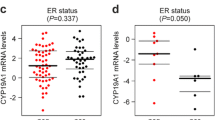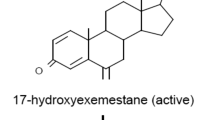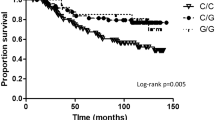Abstract
Purpose Estrogen exposure is involved in both breast cancer susceptibility and the prognosis in patients with breast cancer. Aromatase is involved in the production of estrogens, and altered expression of it might be associated with the prognosis. The aim of this study was to examine the effect of single nucleotide polymorphisms (SNPs) in the aromatase gene, CYP19A1, on the prognosis, and in relation to tumor and patient characteristics in a cohort of breast cancer patients. Patients and methods The cohort analyzed in this study consisted of 1,257 patients with invasive primary breast cancer. Polymorphisms rs10046, rs4646 and rs700519 were genotyped within this group. Results The variant genotypes of rs10046 and rs4646 were associated with a lower percentage of HER2-positive tumors. There was no association of rs700519 and rs4646 with disease-free survival (DFS) or overall survival (OS). The variant genotype of rs10046 was significantly associated with a better 5-year DFS (hazards ratio 0.51; 95% CI, 0.32 to 0.81; P = 0.004) adjusted for age, nodal status, tumor size grading, and hormone receptor status. This effect appeared to be determined in the subgroup of premenopausal patients. Conclusion SNPs rs10046 and rs4646 may influence the HER2 status of breast cancer tumors, and rs10046 genotypes are associated with an altered DFS. Genotypes of aromatase polymorphisms may influence the prognosis for breast cancer patients not only by affecting the extent of estrogen exposure but also through an alteration in tumor characteristics.



Similar content being viewed by others
References
Yager JD, Davidson NE (2006) Estrogen carcinogenesis in breast cancer. N Engl J Med 354:270–282
Clemons M, Goss P (2001) Estrogen and the risk of breast cancer. N Engl J Med 344:276–285
Early Breast Cancer Trialists’ Collaborative Group (2005) Effects of chemotherapy and hormonal therapy for early breast cancer on recurrence and 15-year survival: an overview of the randomised trials. Lancet 365:1687–1717
Coombes RC, Hall E, Gibson LJ et al (2004) A randomized trial of exemestane after two to three years of tamoxifen therapy in postmenopausal women with primary breast cancer. N Engl J Med 350:1081–1092
Baum M, Budzar AU, Cuzick J et al (2002) Anastrozole alone or in combination with tamoxifen versus tamoxifen alone for adjuvant treatment of postmenopausal women with early breast cancer: first results of the ATAC randomised trial. Lancet 359:2131–2139
Baum M, Buzdar A, Cuzick J et al (2003) Anastrozole alone or in combination with tamoxifen versus tamoxifen alone for adjuvant treatment of postmenopausal women with early-stage breast cancer: results of the ATAC (Arimidex, Tamoxifen Alone or in Combination) trial efficacy and safety update analyses. Cancer 98:1802–1810
Jakesz R, Jonat W, Gnant M et al (2005) Switching of postmenopausal women with endocrine-responsive early breast cancer to anastrozole after 2 years’ adjuvant tamoxifen: combined results of ABCSG trial 8 and ARNO 95 trial. Lancet 366:455–462
Goss PE, Ingle JN, Martino S et al (2005) Randomized trial of letrozole following tamoxifen as extended adjuvant therapy in receptor-positive breast cancer: updated findings from NCIC CTG MA.17. J Natl Cancer Inst 97:1262–1271
Goss PE, Ingle JN, Martino S et al (2003) A randomized trial of letrozole in postmenopausal women after five years of tamoxifen therapy for early-stage breast cancer. N Engl J Med 349:1793–1802
Thurlimann B, Keshaviah A, Coates AS et al (2005) A comparison of letrozole and tamoxifen in postmenopausal women with early breast cancer. N Engl J Med 353:2747–2757
Simpson ER, Mahendroo MS, Means GD et al (1994) Aromatase cytochrome P450, the enzyme responsible for estrogen biosynthesis. Endocr Rev 15:342–355
Berstein LM, Imyanitov EN, Kovalevskij AJ et al (2004) CYP17 and CYP19 genetic polymorphisms in endometrial cancer: association with intratumoral aromatase activity. Cancer Lett 207:191–196
O’Neill JS, Elton RA, Miller WR (1988) Aromatase activity in adipose tissue from breast quadrants: a link with tumour site. Br Med J (Clin Res Ed) 296:741–743
Zeitoun K, Takayama K, Michael MD et al (1999) Stimulation of aromatase P450 promoter (II) activity in endometriosis and its inhibition in endometrium are regulated by competitive binding of steroidogenic factor-1 and chicken ovalbumin upstream promoter transcription factor to the same cis-acting element. Mol Endocrinol 13:239–253
Agarwal VR, Bulun SE, Leitch M et al (1996) Use of alternative promoters to express the aromatase cytochrome P450 (CYP19) gene in breast adipose tissues of cancer-free and breast cancer patients. J Clin Endocrinol Metab 81:3843–3849
Acien P, Velasco I, Gutierrez M et al (2007) Aromatase expression in endometriotic tissues and its relationship to clinical and analytical findings. Fertil Steril 88:32–38
Pathirage N, Di Nezza LA, Salmonsen LA et al (2006) Expression of aromatase, estrogen receptors, and their coactivators in patients with endometrial cancer. Fertil Steril 86:469–472
Lu J, Li H, Cao D et al (2007) Clinical significance of aromatase protein expression in axillary node negative breast cancer. J Cancer Res Clin Oncol 133:401–409
Ribeiro FS, de Amorim LM, de Almeida Simao T et al (2006) CYP19 (TTTA)n polymorphism and breast cancer risk in Brazilian women. Toxicol Lett 164:90–95
Okobia MN, Bunker CH, Zmuda JM et al (2006) Simple tandem repeat (TTTA)n polymorphism in CYP19 (aromatase) gene and breast cancer risk in Nigerian women. J Carcinog 5:12
Kristensen VN, Andersen TI, Lindblom A et al (1998) A rare CYP19 (aromatase) variant may increase the risk of breast cancer. Pharmacogenetics 8:43–48
Baxter SW, Choong DY, Eccles DM et al (2001) Polymorphic variation in CYP19 and the risk of breast cancer. Carcinogenesis 22:347–349
Miyoshi Y, Ando A, Hasegawa S et al (2003) Association of genetic polymorphisms in CYP19 and CYP1A1 with the oestrogen receptor-positive breast cancer risk. Eur J Cancer 39:2531–2537
Probst-Hensch NM, Ingles SA, Diep AT et al (1999) Aromatase and breast cancer susceptibility. Endocr Relat Cancer 6:165–173
Thyagarajan B, Brott M, Mink P et al (2004) CYP1B1 and CYP19 gene polymorphisms and breast cancer incidence: no association in the ARIC study. Cancer Lett 207:183–189
Ralph DA, Zhao LP, Aston CE et al (2007) Age-specific association of steroid hormone pathway gene polymorphisms with breast cancer risk. Cancer 109:1940–1948
Olson JE, Ingle JN, Ma CX et al (2007) A comprehensive examination of CYP19 variation and risk of breast cancer using two haplotype-tagging approaches. Breast Cancer Res Treat 102:237–247
Kristensen VN, Harada N, Yoshimura N et al (2000) Genetic variants of CYP19 (aromatase) and breast cancer risk. Oncogene 19:1329–1333
Haiman CA, Hankinson SE, Spiegelman D et al (2002) No association between a single nucleotide polymorphism in CYP19 and breast cancer risk. Cancer Epidemiol Biomarkers Prev 11:215–216
Ma CX, Adjei AA, Salavaggione OE et al (2005) Human aromatase: gene resequencing and functional genomics. Cancer Res 65:11071–11082
Dunning AM, Dowsett M, Healey CS et al (2004) Polymorphisms associated with circulating sex hormone levels in postmenopausal women. J Natl Cancer Inst 96:936–945
Tworoger SS, Chubak J, Aiello EJ et al (2004) Association of CYP17, CYP19, CYP1B1, and COMT polymorphisms with serum and urinary sex hormone concentrations in postmenopausal women. Cancer Epidemiol Biomarkers Prev 13:94–101
Haiman CA, Dossus L, Setiawan VW et al (2007) Genetic variation at the CYP19A1 locus predicts circulating estrogen levels but not breast cancer risk in postmenopausal women. Cancer Res 67:1893–1897
Guo Y, Xiong DH, Yang TL et al (2006) Polymorphisms of estrogen-biosynthesis genes CYP17 and CYP19 may influence age at menarche: a genetic association study in Caucasian females. Hum Mol Genet 15:2401–2408
Long JR, Kataoka N, Shu XO et al (2006) Genetic polymorphisms of the CYP19A1 gene and breast cancer survival. Cancer Epidemiol Biomarkers Prev 15:2115–2122
Blamey RW, Cataliotti L (2006) EUSOMA accreditation of breast units. Eur J Cancer 42:1331–1337
Elston EW, Ellis IO (1993) Method for grading breast cancer. J Clin Pathol 46:189–190
Wolff AC, Hammond ME, Schwartz JN et al (2007) American Society of Clinical Oncology/College of American Pathologists guideline recommendations for human epidermal growth factor receptor 2 testing in breast cancer. J Clin Oncol 25:118–145
Talbott KE, Gammon MD, Kibriya MG et al (2007) A CYP19 (aromatase) polymorphism is associated with increased premenopausal breast cancer risk. Breast Cancer Res Treat. doi:10.1007/s10549-007-9794-2
Zhu L, Chow LW, Loo WT et al (2004) Her2/neu expression predicts the response to antiaromatase neoadjuvant therapy in primary breast cancer: subgroup analysis from celecoxib antiaromatase neoadjuvant trial. Clin Cancer Res 10:4639–4644
Acknowledgment
Funded in part by a grant of the ELAN-Fond of the University Hospital of Erlangen.
Author information
Authors and Affiliations
Corresponding author
Electronic supplementary material
Rights and permissions
About this article
Cite this article
Fasching, P.A., Loehberg, C.R., Strissel, P.L. et al. Single nucleotide polymorphisms of the aromatase gene (CYP19A1), HER2/neu status, and prognosis in breast cancer patients. Breast Cancer Res Treat 112, 89–98 (2008). https://doi.org/10.1007/s10549-007-9822-2
Received:
Accepted:
Published:
Issue Date:
DOI: https://doi.org/10.1007/s10549-007-9822-2




